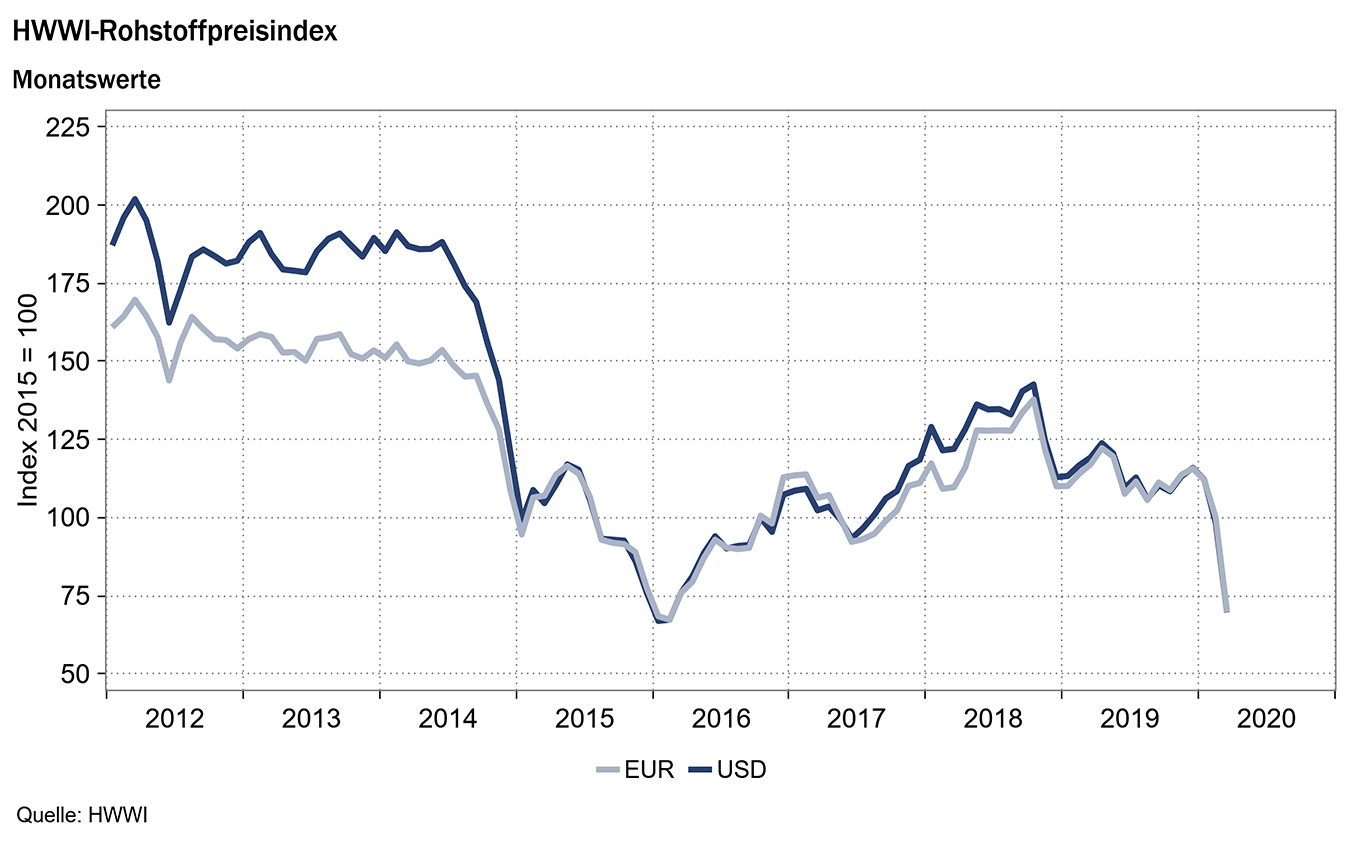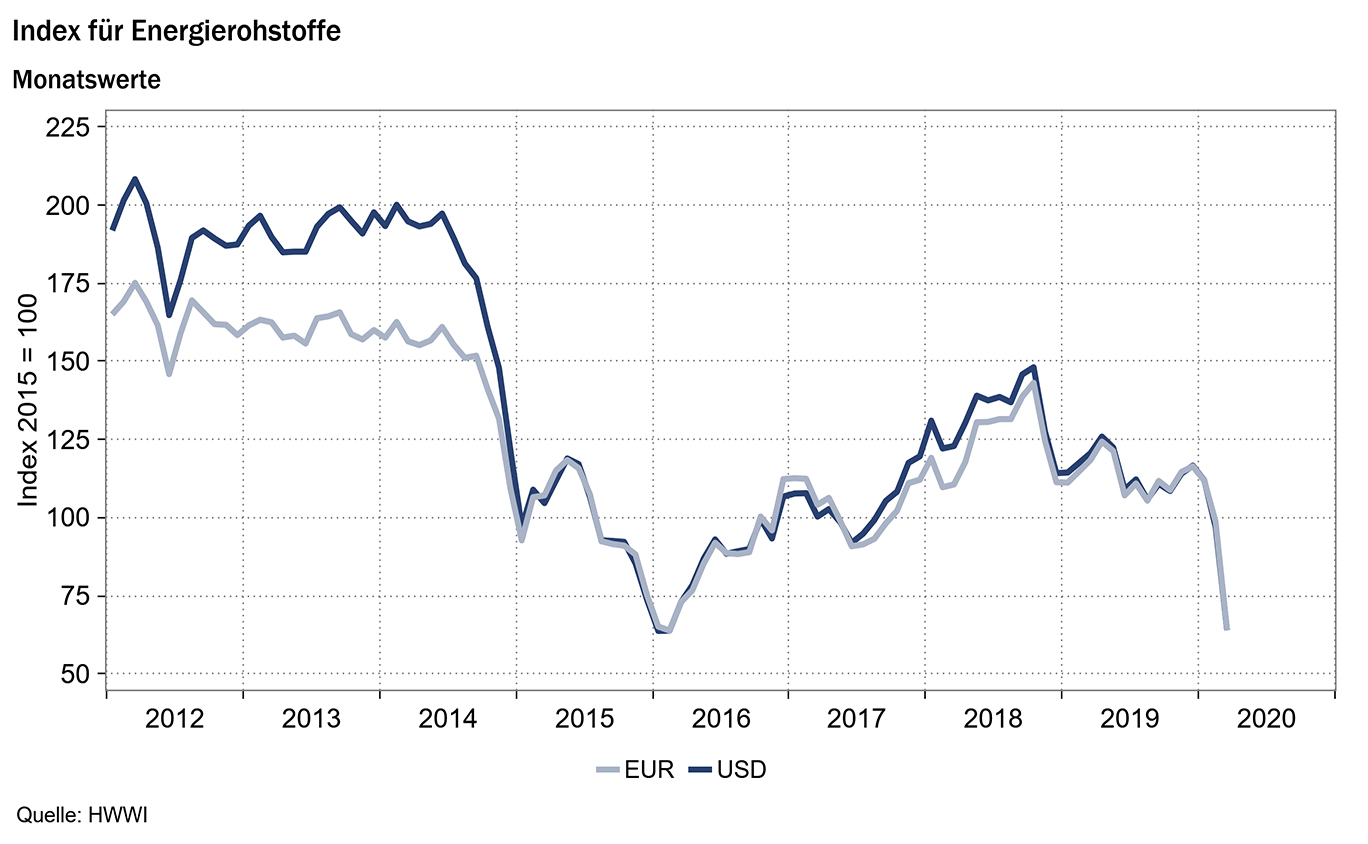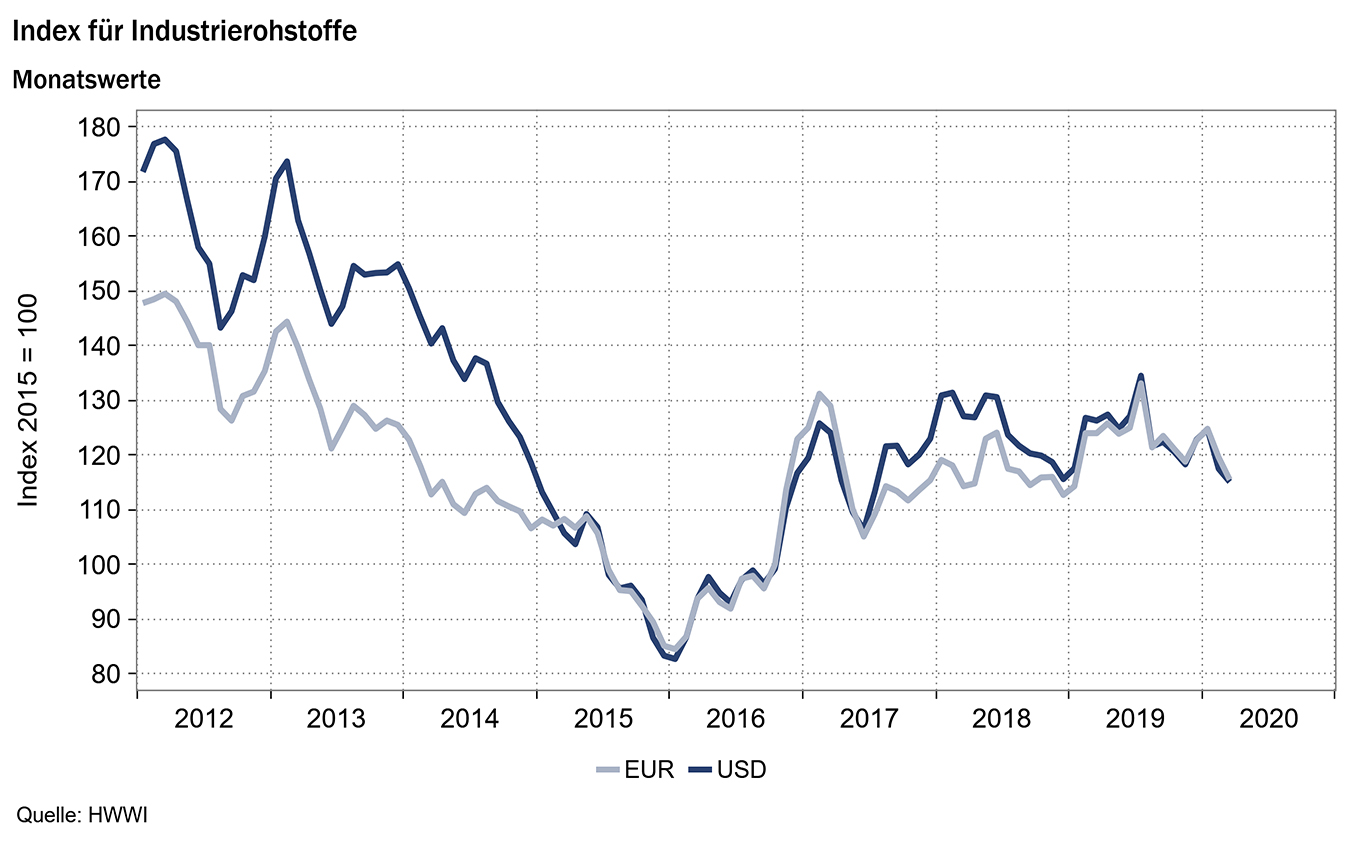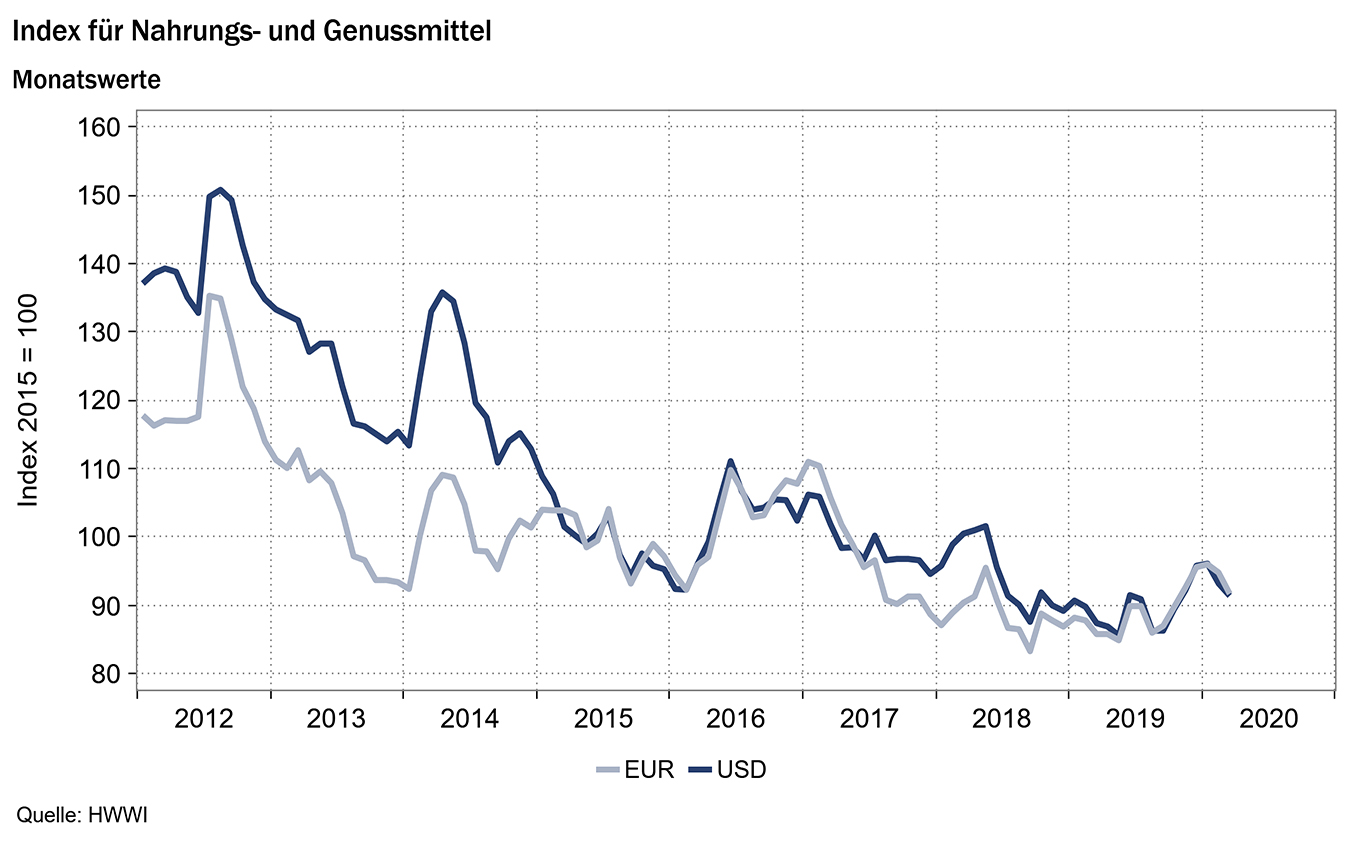HWWI commodity price index continues to fall due to the Corona crisis
- HWWI commodity price index fell by 29.2 % (US dollar base)
- 38.6 % decrease in crude oil prices
- Price decline of 2.1 % on the markets for industrial raw materials
(Hamburg, April 16, 2020) The HWWI commodity price index fell in March compared to the previous month by an average of 29.2 % (Euro base: -30.4 %) to 69.6 points (Euro base: 69.7 points). Developments on the commodity markets were
significantly influenced by the worldwide spread of the coronavirus and the quarantine measures imposed by the states. Due to the slowdown in the global economy, all indices included in the HWWI raw materials index fell in March on average compared to the previous month. In March, the sub-index for energy raw materials fell particularly sharply by an average of -34.1 % (Euro base: -35.2 %) to 63.9 points (Euro base: 63.9 points) and the index for industrial raw materials by 2.1 % (Euro base: -3.5 %) to 115.1 points (Euro base: 115.5 points). The index for food and beverages recorded a relatively small decrease of 1.9 % (Euro base: -3.3 %) to 91.4 points (euro base: 91.7 points). Compared with the previous month, the index excluding energy decreased on average by 2.0% (Euro base: -3.4%) to 105.4 points (Euro base: 105.7 points).

Index for energy raw materials: -34.1 % (Euro base: -35.2 %)
The falling price trend on the oil markets continued and intensified significantly in March. The coronavirus spread, not only in China but also worldwide, and paralysed the economy in many countries. The lockdowns imposed worldwide led to empty roads, a sharp drop in air traffic and a downturn in global industry. The quarantine measures slowed down the global economy and led to a significant drop in global demand for crude oil. The prices of all three types of crude oil included in the index fell continuously in March, recording an average price drop of over 38 % compared to the previous month (Euro base: -39.6 %). On March 30, prices fell to the monthly low of $22.74 per barrel of Brent crude oil and $20.09 per barrel of WTI crude oil.
The price war between the producer countries Saudi Arabia and Russia intensified the price decline on the crude oil markets. Russia refused to agree to the additional production cuts proposed by Saudi Arabia to support the oil price. Saudi Arabia then announced that it would expand its own oil production instead of reducing it, and Russia also threatened to increase production. No agreement was reached between Russia and Saudi Arabia in March. The price war between Saudi Arabia and Russia and the resulting increase in supply, combined with a decline in global demand due to the corona pandemic, led to a huge drop in prices on the oil markets.
Compared with oil prices, natural gas prices fell only moderately in March. Due to the enormous drop in oil prices, US shale oil producers have already announced investment cutbacks. Since American fracking gas is a by-product of American shale oil production, the investment cuts will also lead to a reduction in US natural gas supplies. The reduction in natural gas demand due to the global lockdown had a counteracting effect, with the result that American natural gas prices fell by 6.1 % (Euro base: -7.5 %) and European natural gas prices by 5.4 % (Euro base: -6.8 %) on average in March.
Overall, the sub-index for energy raw materials fell by 34.1 % (Euro base: -35.2 %) to 63.9 points (Euro base: 63.9 points).

Industrial raw materials index: -2.1 % (Euro base: -3.5 %)
The sub-index for industrial raw materials is divided into the index for agricultural raw materials, the index for non-ferrous metals and the index for iron ore and steel scrap. Prices for industrial raw materials also fell in March, although the negative monthly growth slowed down compared to the previous month. While prices for agricultural commodities and those for base metals continued to fall, iron ore prices rose on average in March.
The prices of agricultural raw materials fell in response to the global decline in demand for cotton, wool and skins. The textile industry, especially in the Asian low-wage countries, is currently suffering greatly from the global lockdown and the associated decline in demand.
The prices of non-ferrous metals, especially zinc and copper, also fell considerably in March compared with the previous month. The global lockdown reduced both supply and demand for base metals. However, the decline in demand due to the global slowdown in economic activity outweighed the decline in supply and led to falling prices. The considerable price losses on the copper market also reflected the great uncertainty of market participants and the fears of a global recession.
One exception was the 4.9 % increase in the price of iron ore (Euro base: +3.4 %) in March compared with the previous month. The production volume of large Brazilian iron ore mines declined due to bad weather conditions. In addition, the production of Chinese mines was severely restricted due to the coronavirus, which further reduced the supply of iron ore. As China’s economy slowly returned to normal in March and Chinese steel production increased again, Chinese demand for iron ore also rose. However, iron ore prices may fall again in April as demand from Europe, South Korea, Japan and the US will fall due to the lockdowns there.
Overall, the index for industrial raw materials fell by 2.1 % (Euro base: -3.5 %) to 115.1 points (Euro base: 115.5 points) on a monthly average.

Food and beverages index: -1.9 % (Euro base: -3.3 %)
The index for food and beverages fell by only 1.9 % in March (Euro base: -3.3 %), a relatively small decline compared with the developments of the other sub-indices. However, the majority of the commodities included in the index fell sharply in March.
The price of sugar fell particularly sharply by a monthly average of 21.7 % (Euro base: -22.9 %) compared to the previous month. The prices for sugar and the prices for corn fell in March, as the processing of the raw materials into bioethanol was less lucrative due to the lower crude oil prices. For the same reason, the prices of vegetable oils such as soybean oil, palm oil and sunflower oil also fell on average in March. The vegetable oils are used for the production of biodiesel, which was also reduced in March due to the low crude oil price. Prices for tea and cocoa also fell sharply, reflecting a decline in global demand caused by the global lockdown measures.
In contrast, coffee and rice prices rose significantly in March compared with the previous month. The markets for coffee were already characterised by a shortage of supply before the Corona pandemic. In March, demand for coffee also increased. Coffee roasters and traders feared supply disruptions caused by restrictions due to the corona pandemic and therefore increased their stocks and brought forward orders.
Rice prices rose also considerably. Many Asian producer countries, including India, imposed nationwide curfews to slow the spread of the coronavirus. The strict curfews led to problems in rice harvesting due to labour shortages and logistical difficulties. Major producing countries such as India, Vietnam and Thailand have already stopped rice exports to ensure food supplies in their own countries. Fears of food shortages have also led farmers and traders to increase their rice stocks, and consumers to increase their purchases.
Overall, the index for food and beverages fell by -1.9 % (Euro base: -3.3 %) on a monthly average to 91.4 points (Euro base: 91.7 points).

Source: www.hwwi.org
